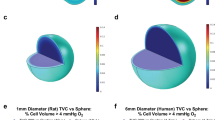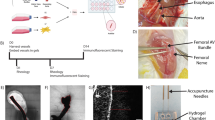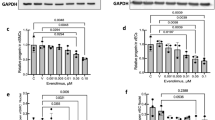Abstract
Several works have shown the feasibility of engineering functional blood vessels in vivo using human endothelial cells (ECs). Going further, we explored the therapeutic potential of neovessels after gene-modifying the ECs for the secretion of a therapeutic protein. Given that these vessels are connected with the host vascular bed, we hypothesized that systemic release of the expressed protein is immediate. As a proof of principle, we used primary human ECs transduced with a lentiviral vector for the expression of a recombinant bispecific αCEA/αCD3 antibody. These ECs, along with mesenchymal stem cells as a source of mural cells, were embedded in Matrigel and subcutaneously implanted in nude mice. High antibody levels were detected in plasma for 1 month. Furthermore, the antibody exerted a therapeutic effect in mice bearing distant carcinoembryonic-antigen (CEA)-positive tumors after inoculation of human T cells. In summary, we show for the first time the therapeutic effect of a protein locally secreted by engineered human neovessels.
This is a preview of subscription content, access via your institution
Access options
Subscribe to this journal
Receive 12 print issues and online access
$259.00 per year
only $21.58 per issue
Buy this article
- Purchase on Springer Link
- Instant access to full article PDF
Prices may be subject to local taxes which are calculated during checkout




Similar content being viewed by others
References
Koike N, Fukumura D, Gralla O, Au P, Schechner JS, Jain RK . Tissue engineering: creation of long-lasting blood vessels. Nature 2004; 428: 138–139.
Sanz L, Santos-Valle P, Alonso-Camino V, Salas C, Serrano A, Vicario JL et al. Long-term in vivo imaging of human angiogenesis: critical role of bone marrow-derived mesenchymal stem cells for the generation of durable blood vessels. Microvasc Res 2008; 75: 308–314.
Au P, Tam J, Fukumura D, Jain RK . Bone marrow-derived mesenchymal stem cells facilitate engineering of long-lasting functional vasculature. Blood 2008; 111: 4551–4558.
Melero-Martin JM, Khan ZA, Picard A, Wu X, Paruchuri S, Bischoff J . In vivo vasculogenic potential of human blood-derived endothelial progenitor cells. Blood 2007; 109: 4761–4768.
Melero-Martin JM, De Obaldia ME, Kang SY, Khan ZA, Yuan L, Oettgen P et al. Engineering robust and functional vascular networks in vivo with human adult and cord blood-derived progenitor cells. Circ Res 2008; 103: 128–130.
Sanz L, Kristensen P, Blanco B, Faceteau S, Russell SJ, Winter G et al. Single-chain antibody-based gene therapy: inhibition of tumor growth by in situ production of phage-derived human antibody fragments blocking functionally active sites of cell-associated matrices. Gene Therapy 2002; 15: 1049–1053.
Blanco B, Holliger P, Vile RG, lvarez-Vallina L . Induction of human T lymphocyte cytotoxicity and inhibition of tumor growth by tumor-specific diabody-based molecules secreted from gene-modified bystander cells. J Immunol 2003; 171: 1070–1077.
Compte M, Blanco B, Serrano F, Cuesta AM, Sanz L, Bernad A et al. Inhibition of tumor growth in vivo by in situ secretion of bispecific anti-CEA x anti-CD3 diabodies from lentivirally transduced human lymphocytes. Cancer Gene Ther 2007; 14: 380–388.
Holliger P, Hudson PJ . Engineered antibody fragments and the rise of single domains. Nat Biotechnol 2005; 23: 1126–1136.
Compte M, Cuesta AM, Sánchez-Martín D, Alonso-Camino V, Vicario JL, Sanz L et al. Tumor immunotherapy using gene-modified human mesenchymal stem cells loaded into synthetic extracellular matrix scaffolds. Stem Cells 2009; 27: 753–760.
Holliger P, Manzke O, Span M, Hawkins RE, Fleischmann B, Qinghua L et al. Carcinoembryonic antigen (CEA)-specific T-cell activation in colon carcinoma induced by anti-CD3 × anti-CEA bispecific diabodies and B7 × anti-CEA bispecific fusion proteins. Cancer Res 1999; 59: 2909–2916.
Bargou R, Leo E, Zugmaier G, Klinger M, Goebeler M, Know S et al. Tumor regression in cancer patients by very low doses of a T cell-engaging antibody. Science 2008; 321: 974–977.
Holliger P, Prospero T, Winter G . ‘Diabodies:’ small bivalent and bispecific antibody fragments. Proc Natl Acad Sci USA 1993; 90: 6444–6448.
Perisic O, Webb PA, Holliger P, Winter G, Williams RL . Crystal structure of a diabody, a bivalent antibody fragment. Structure 1994; 2: 1217–1226.
Lazennec G, Jorgensen C . Concise review: adult multipotent stromal cells and cancer: risk or benefit? Stem Cells 2008; 26: 1387–1394.
Segal DM, Weiner GJ, Weiner LM . Bispecific antibodies in cancer therapy. Curr Opin Immunol 1999; 11: 558–562.
Sanz L, Blanco B, Alvarez-Vallina L . Antibodies and gene therapy: teaching old ‘magic bullets’ new tricks. Trends Immunol 2004; 25: 85–91.
Aboody KS, Najbauer J, Danks MK . Stem and progenitor cell-mediated tumor selective gene therapy. Gene Therapy 2008; 15: 739–752.
Karnoub AE, Dash AB, Vo AP, Sullivan A, Brooks MW, Bell GW et al. Mesenchymal stem cells within tumour stroma promote breast cancer metastasis. Nature 2007; 49: 557–563.
Roth JC, Curiel DT, Pereboeva L . Cell vehicle targeting strategies. Gene Therapy 2008; 15: 716–729.
Eliopoulos N, Francois M, Boivin MN, Martienau D, Galipeau J . Neo-organoid of marrow mesenchymal stromal cells secreting interleukin-12 for breast cancer therapy. Cancer Res 2008; 68: 4810–4818.
Acknowledgements
This work was supported by grants from the Ministerio de Ciencia e Innovación (BIO2008-03233), the Comunidad Autónoma de Madrid (S-BIO-0236-2006) and the European Union (Immunonet–SUDOE) to LA-V; and from the Fondo de Investigación Sanitaria (PI061621) to LS. MC was supported by Instituto de Salud Carlos III (Contrato Rio Hortega, CM06/00055). DS-M was supported by a Comunidad Autónoma de Madrid/European Social Fund training grant (FPI-000531). LS is an investigator from the Ramón y Cajal Program (Ministerio de Ciencia e Innovación), co-financed by the European Social Fund. VAC is a predoctoral fellow from the Gobierno Vasco (BFI07.132).
Author information
Authors and Affiliations
Corresponding authors
Ethics declarations
Competing interests
The authors declare no conflict of interest.
Additional information
Supplementary Information accompanies the paper on Gene Therapy website
Rights and permissions
About this article
Cite this article
Compte, M., Alonso-Camino, V., Santos-Valle, P. et al. Factory neovessels: engineered human blood vessels secreting therapeutic proteins as a new drug delivery system. Gene Ther 17, 745–751 (2010). https://doi.org/10.1038/gt.2010.33
Received:
Revised:
Accepted:
Published:
Issue Date:
DOI: https://doi.org/10.1038/gt.2010.33
Keywords
This article is cited by
-
Bispecific light T-cell engagers for gene-based immunotherapy of epidermal growth factor receptor (EGFR)-positive malignancies
Cancer Immunology, Immunotherapy (2018)
-
Balanced secretion of anti-CEA × anti-CD3 diabody chains using the 2A self-cleaving peptide maximizes diabody assembly and tumor-specific cytotoxicity
Gene Therapy (2017)
-
In vivo secretion of anti-CD3 × anti-tumor bispecific antibodies by gene-modified cells: over a decade of T-cell engagement
Molecular Therapy (2015)
-
Basement Membrane Matrix (BME) has Multiple Uses with Stem Cells
Stem Cell Reviews and Reports (2012)



